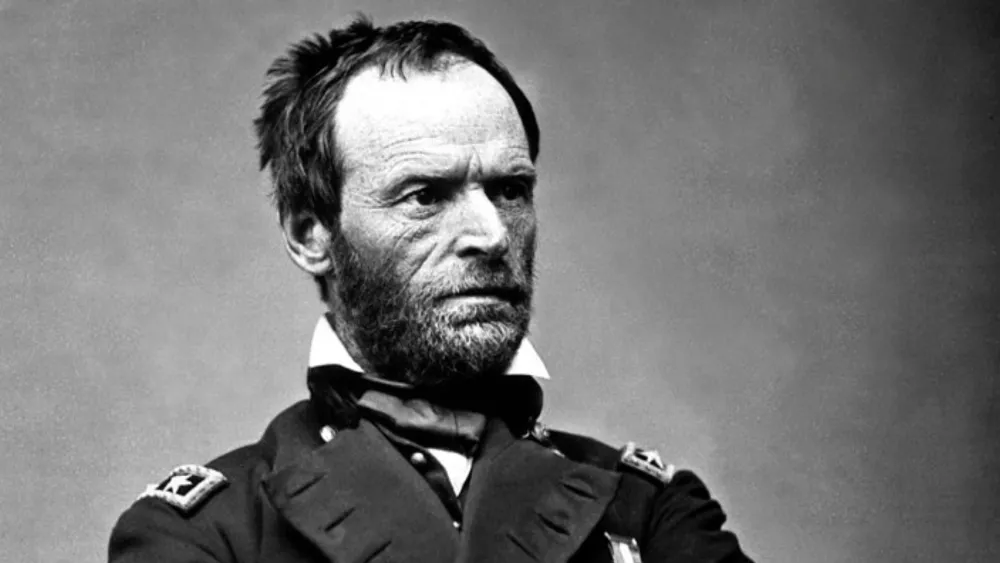The chronicles of history are rife with individuals who have had a lasting impression on the course of affairs, influencing the fates of nations and testing our conceptions of leadership. William Tecumseh Sherman is one such person who stands out in this pantheon.
His name resonates throughout history as a Civil War commander, a brilliant strategist, and a contentious character. Moreover, Sherman’s deeds and legacy continue to spark passionate discussions among historians and researchers.
Sherman’s life and multifaceted career reveal a character whose influence on American history remains complex. Moreover, Sherman is frequently remembered for his infamous “March to the Sea,” a campaign still celebrated and derided.
Early Life and Ambitions
Born in Lancaster, Ohio, William Tecumseh Sherman grew up in a country unsure of its history and destiny. He was determined to find stability through school and military duty because of the early death of his father and the subsequent financial hardships. So, it foreshadowed the unyielding commitment that would later characterize his military battles.
After earning his degree from the United States Military Academy at West Point in 1840, Sherman began a military career that would take him through the turbulent years leading up to the Civil War. The years that followed ultimately led to his position as one of the most important generals for the Union.
Charles Taylor Sherman, the elder brother of Sherman, became a federal judge. John Sherman, one of his younger brothers, was a Republican Party founder, a U.S. congressman, a senator, and a cabinet secretary. Hoyt Sherman, a different younger brother, was a prosperous banker.
Two of his foster brothers, Hugh Boyle Ewing and Thomas Ewing Jr., became major generals in the Union Army during the Civil War. Hugh Boyle Ewing later went on to become an ambassador and a novelist. On the other hand, Thomas Ewing Jr. served as a defense lawyer in the military trials of the Lincoln conspirators.
The Civil War and the Ascendance to Notoriety
Sherman’s strategic genius propelled him into the upper echelons of military fame when the cannons of war roared to life in 1861. Under the steady leadership of General Ulysses S. Grant, Sherman played a crucial role in operations that built the tactical foundation for the Union’s ultimate victory.
His creative thinking, flexibility to change battlefronts, and exceptional leadership qualities earned him the admiration of his colleagues and the affectionate moniker “Cump” among his men. However, Sherman would leave a lasting impression on history because of his innovative fighting strategy.
The Infamous “March to the Sea”
Among Sherman’s many wars, the notorious “March to the Sea” in 1864 best captures his tactical mastery and moral depth. He staged a risky and contentious maneuver with unyielding commitment, leading his troops on a relentless march from Atlanta to Savannah.
The path of devastation they left behind along the route was extraordinary; crops were destroyed, vital infrastructure was reduced to ruins, and civilian property took the brunt of war’s wrath.
Sherman bore the brunt of war’s wrath. His deliberate objective was to erode the South’s resolve to continue the fight. Employing psychological warfare, he sought to demoralize both Confederate troops and civilians. Some historians argue that Sherman’s tactics were crucial in hastening the war’s end, while others view the ‘March to the Sea’ as a morally dubious campaign. They believe that it is marked by unjustified civilian suffering and a significant departure from accepted military practice.
William Tecumseh Sherman: Rising through the Ranks
Major Don Carlos Buell had suggested Sherman apply for the position, which he did with the help of General George Mason Graham. Sherman served as the organization’s president and was both a successful and well-liked figure.
John, the younger brother of Sherman, was acting from his U.S. Congress as a well-known opponent of slavery. However, prior to the Civil War, William T. had shown some pity for the white Southerners’ protection of the institution of slavery in their ancient agricultural economy.
On the other hand, he vehemently opposed the southern states’ secession. He grew close to Professor David French Boyd in Louisiana, a Virginia native and ardent separatist.
Boyd remembered what he saw: “Sherman cried, and began, in his nervous way. Pacing the floor and deprecating the step. Which he feared might bring destruction on the whole country.” When word of South Carolina’s secession from the United States reached them at the Seminary.

Leadership Dilemmas of William Tecumseh Sherman
As complex as the historical fabric, Sherman’s legacy is marked by adoration and scorn. His strategic mastery was crucial in ending the Civil War. But his tactics, notably those used during the “March to the Sea,” are still the subject of heated ethical dispute.
The idea of “total war,” which entails using civilian populations to weaken an enemy’s resolve, poses challenging issues regarding the morality of combat and the limits of proper behavior. In addition, Sherman’s post-war activities as the army’s commanding general saw him tackling the difficulties of Reconstruction.
His inability to stop the loss of newly liberated African Americans’ civil rights, despite his support for a more forgiving stance toward the vanquished Confederacy, highlights the limits of his authority within the larger geopolitical environment.
William Tecumseh Sherman and his historical echoes
The legacy of William Tecumseh Sherman is evidence of the complex interplay between strategy, morality, and the long-term effects of human deeds. He was unquestionably a superb tactician, and history will forever remember his contributions to the Civil War’s conclusion.
However, his actions, particularly during the “March to the Sea,” continue to spark reflection and discussion, serving as a reminder that even well-known people are subject to moral judgment. Because of Sherman’s life and career, we must approach history from a nuanced perspective. It considers both his skill as a strategist and the difficult moral choices that his legacy entails.
By doing this, we acknowledge the complicated reasons of those who have molded our past and the long-lasting effects of their decisions. By engaging with the many facets of history, we develop a deeper knowledge of the forces that have created our world.
Sherman’s story serves as a sad reminder. That history is a complicated interaction of circumstances, beliefs, and human frailties rather than a straight narrative of heroes and villains.




